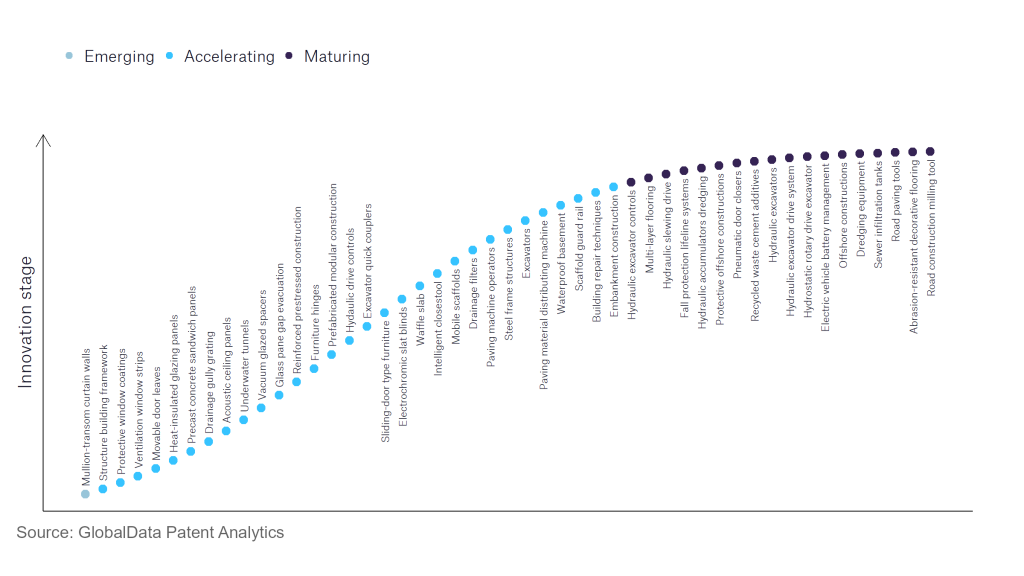The construction industry continues to be a hotbed of innovation, with activity driven by an increased focus on environmental sustainability, workplace safety and circular construction, and the growing importance of technologies such as the Internet of Things (IoT), robotics and modular construction. In the last three years alone, there have been over 248,000 patents filed and granted in the construction industry, according to GlobalData’s report on Innovation in Construction: Excavator quick couplers. Buy the report here.
However, not all innovations are equal and nor do they follow a constant upward trend. Instead, their evolution takes the form of an S-shaped curve that reflects their typical lifecycle from early emergence to accelerating adoption, before finally stabilising and reaching maturity.
Identifying where a particular innovation is on this journey, especially those that are in the emerging and accelerating stages, is essential for understanding their current level of adoption and the likely future trajectory and impact they will have.
80+ innovations will shape the construction industry
According to GlobalData’s Technology Foresights, which plots the S-curve for the construction industry using innovation intensity models built on over 179,000 patents, there are 80+ innovation areas that will shape the future of the industry.
Within the emerging innovation stage, mullion-transom curtain walls are the disruptive technologies that is in the early stages of application and should be tracked closely. Heat-insulated glazing panels, drainage gully grating, and acoustic ceiling panels are some of the accelerating innovation areas, where adoption has been steadily increasing. Among maturing innovation areas are abrasion-resistant decorative flooring, and road construction milling tool, which are now well established in the industry.
Innovation S-curve for the construction industry

Excavator quick couplers is a key innovation area in construction
A quick coupler, or quick hitch, is an industrial component that fits on a primary mover and allows the rapid installation and changing of work tools such as buckets and other attachments on the arm, improving the working efficiency of machine operators.
GlobalData’s analysis also uncovers the companies at the forefront of each innovation area and assesses the potential reach and impact of their patenting activity across different applications and geographies. According to GlobalData, there are 50 companies, spanning technology vendors, established construction companies, and up-and-coming start-ups engaged in the development and application of excavator quick couplers.
Key players in excavator quick couplers – a disruptive innovation in the construction industry
‘Application diversity’ measures the number of different applications identified for each relevant patent and broadly splits companies into either ‘niche’ or ‘diversified’ innovators.
‘Geographic reach’ refers to the number of different countries each relevant patent is registered in and reflects the breadth of geographic application intended, ranging from ‘global’ to ‘local’.
Patent volumes related to excavator quick couplers
Source: GlobalData Patent Analytics
Leading innovators in the development of excavator quick couplers include Komatsu, a manufacturer of heavy industrial machinery, and Caterpillar, a producer of construction, transportation and energy equipment. Key quick coupler developments by Komatsu include a quick coupler that can enable the automatic actuation and release of a disengagement prevention function with the lock member when attaching and detaching the attachment. Key patents by Caterpillar in the space include a tool holder for coupling a work tool to an arm, comprising an idle link attached to the arm and a power link. A hydraulic ram is provided between the gripping pins on the arm and the gripping pins on the power link, enabling the release or engagement of openings on the work tool.
In terms of geographic reach, leading companies in the development of excavator quick couplers include Esco Technologies, a manufacturer of engineered industrial products and systems, and ALLU Finland, a manufacturer and supplier of stabilising equipment. In terms of application diversity, Toro Company, ALLU Finland and Built Robotics lead the space.
To further understand the key themes and technologies disrupting the construction industry, access GlobalData’s latest thematic research report on Construction.
Data Insights
From

The gold standard of business intelligence.
Blending expert knowledge with cutting-edge technology, GlobalData’s unrivalled proprietary data will enable you to decode what’s happening in your market. You can make better informed decisions and gain a future-proof advantage over your competitors.



